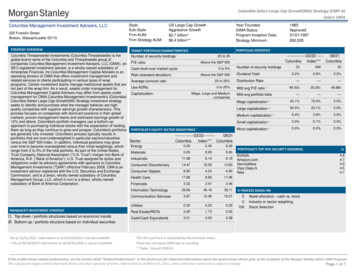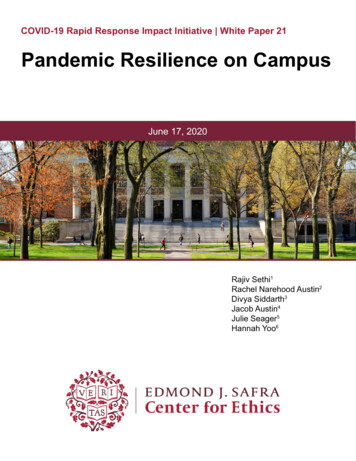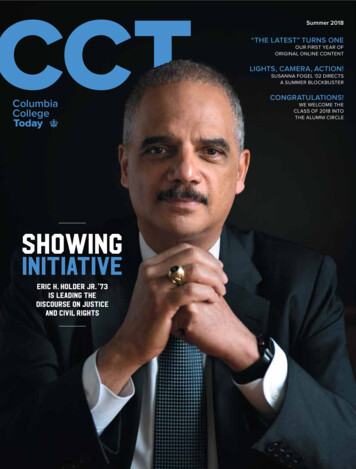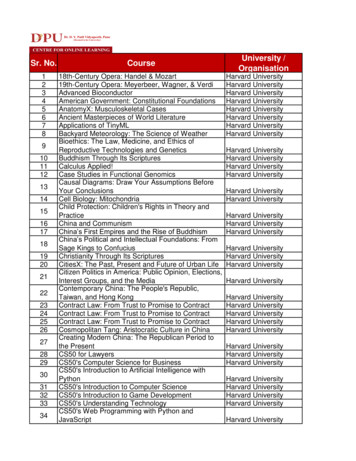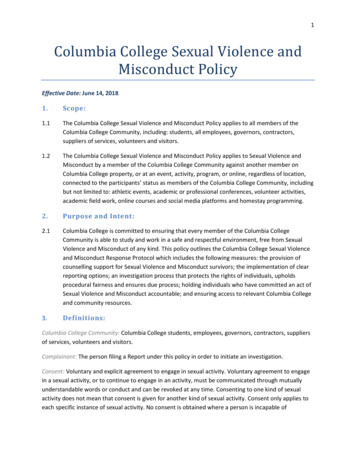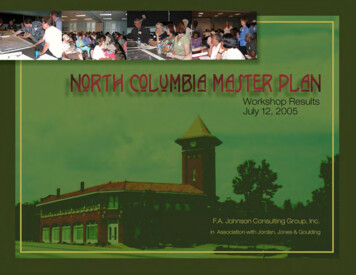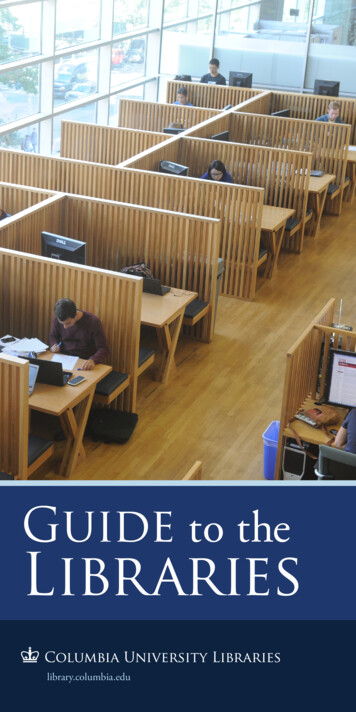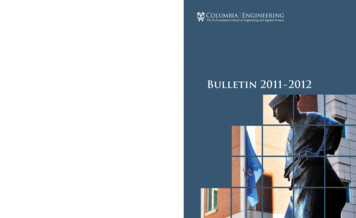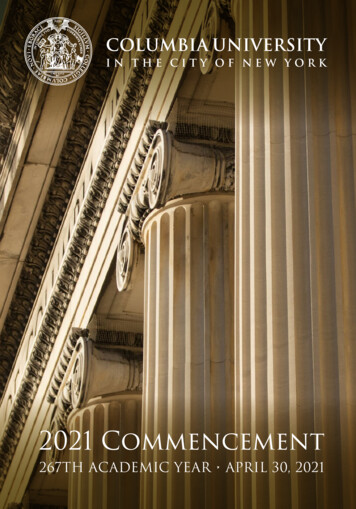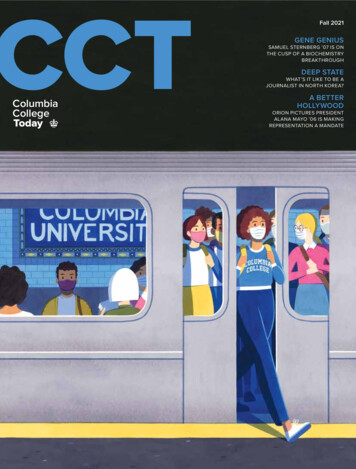
Transcription
Fall 2021GENEGENIUSNETENDASAMUEL STERNBERG ’07 IS ONUT FUGIT,THEFICILLIBUS,CUSP OF A SECTIBIOCHEMISTRYAS SUMEAQUO DI THBREAKTHROUGHSTATEUPTASDEEPDOLESCITEWHAT’SLIKE TOBE ANUMENTI AITNOBITQUIATIJOURNALISTINNORTHKOREA?NE UIS VOAT QUO TE SIMUSANTESOLUPTUMQUO CORColumbiaCollegeTodayA BETTERHOLLYWOODORION PICTURES PRESIDENTALANA MAYO ’06 IS MAKINGREPRESENTATION A MANDATE
Every year, alumni and friends like you make it possible for a new classof Columbia College students to walk through the Gates. They comefrom every kind of background and all have something in common witheach other, and with you: They want to make the world a better place.And they chose Columbia to help them do so.When you support financial aid, you help make a Columbia education areality for more than 50% of our students by providing partial- or full-needsupport that allows them to attend. Learn more about our s/students
Contentsfeatures12Jump StartSamuel Sternberg ’07’s latestdiscovery could be a giant leapin gene editing.By Matthew Hutson18A Journalist’sUnmatched AccessJean H. Lee ’92, JRN’95 looks back on three“illuminating” years working in North Korea.By Nathalie Alonso ’0824Moving the FilmWorld ForwardOrion Pictures president Alana Mayo ’06wants audiences to see themselves on screen.By Scott MeslowCover: Illustration by Eleni Kalorkoti
Contentsdepartmentsalumni news3 Within the Family34 Now Arriving: 116th Street4 The Big Picture: Beloved Butler35 Message from CCAA PresidentTed Schweitzer ’91, LAW’946 Message from Dean James J. Valentini36 Lions7 Around the QuadsAlicia Guevara ’94; Marianna Wright ’91;John D’Emilio ’70, GSAS’8211 Roar, Lion, Roar40 Bookshelf30 Columbia Forum: New York,New York, New York:Four Decades of Success,Excess, and TransformationA historian takes a deep dive into the last40 years of New York City’s metamorphosis.My Ride or Die: A Novel by Leslie Cohen ’0642 Class NotesJust Married!82 ObituariesEdwin Goodgold ’65, Hon. Robert A. Katzmann ’7388 Alumni CornerONLINE EXTRA Thank you to our FY21 CCT donorsTwo College alumni were painted by their famousmother, artist Alice Neel.READ WHAT’S NEW!CCTCCT HAS MORE ONLINE STORIES THAN EVERAn Alum Was the Architect of St. Patrick’s CathedralBoost your knowledge of Columbia history with this “Did You Know?” video short. bit.ly/3DaMJg0Your Favorite Campus PlacesWe asked, you answered: These are the nine spots that Lions love! bit.ly/37XWHmsAlice Neel’s Columbia PaintingsThe subject of a popular show at the Met immortalized alumni, faculty and neighbors. bit.ly/3ex8yM7college.columbia.edu/cct
JÖRG MEYERCCTIWithin the FamilyVOLUME 49 NUMBER 1A Welcome SeasonEDITOR-IN- CHIEFt’s hard to write this column when the world outside my door continues to change soquickly. I’ve delayed as long as I can, but on this hot afternoon in August, the procrastination has to end. Covid-19 still fills the news. Vaccination rates have risen, happily.But so, too, has the insistent strain known as the Delta variant, sending us into yetanother phase of uncertainty. I’d like to say something timely, but what will have changedin the month between when I write these words and when you read them?Still, the current uncertainty feels different, less overwhelming; I think it’s because we’vebeen heartened. We’ve recovered parts of our lives — both the dear and the mundane —that had been lost for so long. Many of us are having meals with friends again. There’s sometravel. We are preparing to resume commutes, return to the office, dust off the furniture andcomputers that sat untouched for more than a year. On campus, professors are again crisscrossing College Walk and students are returning to classrooms. The start of the fall semester typically brings a shot of new-pencil optimism and resolve to make it a good year, andthis September is no different. Indeed, we have never been so ready to make it a good year.We welcome this season of return with a commemorative CCT cover; inside the issue,we feature three alumni who have each in their way broken new ground.Biochemist Samuel Sternberg ’07 is an expert in CRISPR, the revolutionary technology that enables gene editing with relative ease and precision. (Scientists have likened it toplacing a cursor next to a typo and deleting a single letter.) Now, several years into overseeing his own lab at Columbia, Sternberg is on a path of innovation: His research into socalled “jumping genes” could show them to be even better than CRISPR for gene editing.We profile this home-grown scientific star, who graciously welcomed us into his lab for aconversation about his team’s pioneering work.We also introduce Alana Mayo ’06, who is marking one year as the president of OrionPictures, the recently rebooted division of MGM that is focusing exclusively on underrepresented voices. With the studio’s first film in production — and at a time when Hollywood isprioritizing diversity at all levels of movie-making — she’s poised to redefine what it meansto make intelligent, inclusive, forward-thinking cinema. Here, the longtime film buff opensup about her career path and influences, as well as her ambitions to transform an industry.Finally, Jean H. Lee ’92, JRN’95 is a former foreign correspondent with a remarkable storyto tell: She founded the Pyongyang bureau of the Associated Press in 2012, making the AP thefirst international media with a full-time presence in North Korea. Lee recalls the enormouschallenges that came with reporting in the notoriously repressive country, yet the word sheultimately uses to describe the experience is “illuminating.” Read our feature to understand why.I’d also urge you not to miss our back page, where we’re thrilled to publish three portraitsby the great 20th-century painter Alice Neel of her sons, Richard Neel ’61, LAW’64 andHartley Neel ’63. Alice, who was the subject of a major retrospective at the Met this pastsummer, in fact had many Columbia connections, and immortalized a number of alumni,faculty and neighbors in her works. We share more paintings online, along with the exclusive stories behind them: college.columbia.edu/cct.Welcome to all our CC’25 parents reading CCT for the first time. And to all of us,welcome back. May the subway ride to 116th Street never feel so uniquely notable again!ColumbiaCollegeTodayFALL 2021Alexis Boncy SOA’11EXECUTIVE EDITORLisa PalladinoDEPUT Y EDITORJill C. ShomerASSOCIATE EDITORAnne-Ryan Sirju JRN’09FORUM EDITORRose Kernochan BC’82CONTRIBUTING EDITORSJames C. Katz ’72Alex Sachare ’71ART DIRECTOREson ChanPublished three times ayear by Columbia Collegefor alumni, students, faculty,parents and friends.CHIEF COMMUNICATIONSAND MARKETING OFFICERBernice Tsai ’96ADDRESSColumbia College TodayColumbia Alumni Center622 W. 113th St., MC 4530, 4th Fl.New York, NY ege.columbia.edu/cctISSN 0572-7820Opinions expressed arethose of the authors and donot reflect official positionsof Columbia Collegeor Columbia University. 2021 Columbia College TodayAll rights reserved.Alexis Boncy SOA’11Editor-in-ChiefFall 2021 CCT 3
BelovedButlerTo celebrate the return of studentsto Morningside, CCT made a list ofalumni’s favorite campus spaces,culled from more than 150 responsesin our online “Take Five” archivesand polls across our social mediachannels. No spoilers, but the stacks,reading rooms, large tables and cozycorners of Butler Library secured it aspot near the top. “I know it’s geekybut I loved every part of it,” one alumsays. “Being in Butler always mademe feel that I was never alone in thestruggle,” says another. Check out“Your Favorite Campus Places” atcollege.columbia.edu/cct.JENNA BASCOM PHOTOGRAPHY4 CCT Fall 2021
theBigPictureFall 2021 CCT 5
M AT T HE W SE P T I M USMessage from the Deanwrite this letter on a day in late July after a long conversationwith the student leaders responsible for planning and implementing our New Student Orientation Program (NSOP).Like so much else in the past 18 months, it will be an Orientation like no other. It addresses our newest students, the Class of2025, and also our rising sophomores, the Class of 2024, who hada purely online Orientation last year. As the students and I sat andtalked in Lerner Hall, all of us wearing masks, I learned a lot abouttheir plans for NSOP. I also learned something else, somethingmuch more important: that despite all the challenges and difficultieseach of these students has faced for a year and a half, a span of timerepresenting more than a third of their undergraduate experience,they were as optimistic and enthusiastic, as imaginative and creative,as any NSOP leadership group of the past. They acted in the spiritof Beginner’s Mind, seeing new possibilities for how to design thisexperience. Possibilities for our new students and for our not-so-newstudents, as well as possibilities for themselves. It made me feel —and I think should make all of us feel — optimistic about this yearwith our return to on-campus classes and residential life.As I write the verb “return,” I realize that while it is an accurateword for the time — as we indeed are coming back to both a place,our campus, and a set of activities, the education of our students —“return” does not convey what this fall really means for us. That isbecause we all carry an experience of disruption that will changehow we think about our campus and our education. The aphorism“It is impossible to step in the same river twice,” frequently attributed to the pre-Socratic philosopher Heraclitus, comes to mind as awonderfully evocative metaphor for our “return.” How I think aboutour College and the experiences our students will have within it hasbeen altered from what I thought when writing my dean’s letter forCCT ’s Fall 2019 issue.This year’s NSOP leaders are not trying to replicate the structure,the substance or the feeling of 2019’s Orientation. They know thatthe river they are stepping into is a quite different one, even if it looksthe same. I know we are all cognizant of that, but I hope that in thisacademic year we take time, individually and collectively, to considerhow we see our college now, with the new perspective that disruption has provided. How has our assessment of the undergraduateeducation we offer been changed? What new opportunities has thepandemic made us aware of ? What have we learned that we can useto be an even better college?SCOTT RUDDIAn Optimistic Return to Campustimes I even waded into it. And while I have “returned” the Dean’sOffice to Hamilton Hall, I still think about the flowing water inthat brook.As I begin my 11th year as dean, and my 32nd as a Columbiafaculty member, I have been thinking about the flow of studentsthrough our college, the thousands I have taught, advised, writtenletters of recommendation for or just chatted with over the years.This issue of CCT has particular meaning for me in that regard.One of the feature stories is about Sam Sternberg ’07, a biochemistry major who graduated during the time I chaired the chemistrydepartment. Sam was a remarkable student in the classroom andin the lab, and an engaging interlocutor outside those scientificspaces. There is a particular pleasure for me in seeing him, the successful academic researcher, in these pages, and thinking back toseeing him in Havemeyer as a student.For all of us who are faculty members, experiences like this inspirepride in what we do at the College. And no matter how things mightcontinue to change, we know that we will always draw encouragement and satisfaction from seeing our students develop into successful and unique citizens. Roar, Lion(s), Roar!Ispent a lot of time during the pandemic thinking about the meaning of Heraclitus’s river analogy as it pertains to Columbia College. I would sit on the bank of the Ho-Ho-Kus Brook, just a fewsteps from my house, which has been my office during much of thelast 18 months, and watch the ever-changing water flow by; some6 CCT Fall 2021James J. ValentiniDean
AroundtheQuadsMICHAEL DIVITOThe legendary College Bowl quiz show wasback on TV this summer, with a fearsomethreesome from Columbia vying for thefirst championship of a new era. TamarahWallace ’22, Shomik Ghose SEAS’23 andJake Fisher SEAS’22 had made it to thefinals by the time this issue went to press,defeating Morehouse College, the University of Tennessee and Auburn Universityalong the way.The revived show, which originallyaired in the 1960s, is hosted by NFL Hallof Fame quarterback Peyton Manning;students compete for a share of 1 millionin scholarships.The semifinals match on August 24,against Auburn, turned into a real nailbiter, with the Columbia team fallingbehind by as much as 220 points. Askedhow they were feeling, Ghose said theywere just trying to channel the spiritof New York City: hungry, scrappy andresilient. “We hope we can show thatNew Leader forUniversity LifeDennis Mitchell, senior vice provost forfaculty advancement and a professor ofdental medicine at the Columbia University Medical Center, has been namedexecutive VP for university life. Mitchellsucceeds Suzanne Goldberg, who led theoffice for more than six years before stepping down in January to join the BidenHarris administration.GREG GAY NE / NB CBowled Over!same resilience and bounce back,” he saidwith a smile.And they did; the final score was735–695.If the Columbia team wins the championship, scheduled for September 7, it’ll beits second time capturing the crown. Thefour-man team of Elia Racah ’67, JeffreyRosen ’68, Derek Randall ’67 and StevenRoss ’68 won the 1966–67 season witha perfect 5–0 record. Their student foesincluded teams from Providence College, Indiana University, Michigan StateUniversity, William & Mary and, finally,Smith (which notably attempted to intimidate the Lions with a sympathy card sentbefore the taping). Columbia took home atotal of 10,500 in scholarship money.Mitchell, who earned a doctorate indental surgery from Howard University,joined the Columbia faculty in 1991and has held a number of positions atthe Dental School. From 2004 to 2021,he was the first diversity-focused deanat a U.S. dental school in his role as itssenior associate dean for diversity; hewas responsible for a nearly seven-foldincrease in the percentage of studentsfrom underrepresented backgrounds.Mitchell also has been in the Office ofthe Provost for the last seven years, helpingto oversee the University’s now more than 185 million investment in faculty diversity.“An expert clinician, researcher andadministrator, Dennis has devoted his30-year career at Columbia to strengthening our community, perhaps most notablythrough his commitment to fostering aninclusive campus climate for new and risingfaculty members,” President Lee C. Bollinger said in an August 17 announcement.“He is a natural leader for University Life’scritical work of building community amongthe next generation of thought leaders,researchers and innovators — our students.”In taking on his new role, Mitchellwants students to know that they have anadvocate in him and in University Life. “Iknow how central the student experienceis to everything we do at this university,”he said. “We wouldn’t be who we are or dowhat we do without our students, and I’mcommitted to making their time at Columbia as rewarding as it can possibly be.”Public HealthDual DegreeUndergraduates with an interest in publichealth now have a dual-degree option — aso-called “4 1” program that combinesa B.A. from the College with an M.P.H.from the Mailman School of PublicHealth. The result of a new partnershipbetween the schools, the dual degreeenables students to earn an M.P.H., usuallya two-year program, at an accelerated pace.Fall 2021 CCT 7
AroundtheQuadsStudents can apply in their junior year,and upon acceptance will spend the fallsemester of their senior year enrolled atMailman, before returning to the Collegein the spring semester to complete a B.A.After graduating they will matriculate atMailman to complete a practicum anda year of coursework and thesis work toearn a master’s.“Over the past several years, we’ve seenan increase in interest among our studentsin matters related to public health,” DeanJames J. Valentini said. “This partnershipbetween the College and Mailman createsa remarkable opportunity for students tocombine an exceptional liberal arts undergraduate foundation with a world-classprofessional education in public healthin five years. We’re delighted to be ableto offer this special preparation for thefuture leaders in the fields that supportthe health and well-being of populationsaround the world.”College Co-Chairsfor CAAIn a first for the Columbia Alumni Association (CAA), which serves alumni acrossall University schools, a pair of Collegegraduates have been elected to lead theorganization as co-chairs: Michelle EstiloKaiser ’87, PH’92, PS’97 and Mary Kuo’92. The duo will lead several importantinitiatives during the next two years,including the development of the nextfive-year strategic plan. The CAA will alsolaunch the CAA Scholarship program inSeptember, addressing financial, careerand life concerns for students across all 17Columbia schools. Other College alumnielected to their first term on the CAA’sBoard were Peter Kang ’05 and DanielleMaged ’89, BUS’97.LookWho’sTalkingTara HannaYou’ve been at Columbia for nearlya decade! And much of that time wasin Residential Life. What drew you tothe College?The opportunity to work with highachieving students. The College’s studentsare so incredible and passionate — beinga small part of their journeys has beenamazing and has kept me engaged year inand year out. Residential Life is incrediblydynamic, which is what makes it exciting.We see students at all times of the day, intheir homes, during their good times andtheir not-so-good times. We really get toknow students holistically; it’s challengingbut fun at the same time.What’s a typical day for you?There is no typical day, and I love that!Each day brings new challenges and experiences. Much of my day-to-day involvessupporting the Residential Life staff intheir work with students — programming,leadership development, crisis response,wellness, behavioral conduct concerns,housing issues and so on.8 CCT Fall 2021What’s the best part of your job?Helping students feel more at home in theColumbia community, whether that be bysupporting them through a crisis, or helpingthem find connections through fraternities,sororities, special interest communities or intheir residence halls. It is rewarding to seestudents develop a sense of belonging.How has the experience of thepandemic and being remote changedyour thinking for the year ahead?We all have gone through so much duringthe past year and a half, and many studentshaven’t been on campus. Moving into thisyear, Residential Life wants to be intentional about connecting with students tosupport them as they integrate or reintegrate themselves into the community.What are you most looking forwardto as students are welcomed backto campus?The ability to see folks in person — meeting students over Zoom is just not thesame! Being able to connect in person isESON CHANAssociate Dean of Undergraduate Student Lifeand Executive Director of Residential Lifeso valuable, and I really look forward togetting back to that.Do you have any advice orencouragement to share withstudents as they adjust?My advice to all students would be toremember the many resources that are available to you on campus and to not hesitate toreach out if you need something. I encourage everyone to take it one day at a time andto be patient as you experience the highsand lows that come with any big transition.What’s one thing about yourself thatwould surprise readers?I am a Broadway fanatic and have seenmore than 100 shows. I’m very much looking forward to Broadway reopening thisfall! If anyone is looking for a new show,I highly recommend Six, which comesback on September 17. It is super fun andupbeat — like being at a concert. Also,great for any history buffs because it centers on the wives of Henry VIII (I majoredin history so this really hit the spot!).
FacultyLoungeJennifer WenzelBy Jill C. ShomerIt might sound counterintuitive,but Jennifer Wenzel, an associateprofessor of English and comparative literature and Middle Eastern,South Asian, and African Studies(MESAAS), and a scholar of postcolonialliterature, is deeply interested in fossilfuels. Wenzel helped to found the relatively new subfield of energy humanities,which considers the relationship betweenenergy systems and literature, and theways that easy, inexpensive access to fossil fuels shapes our dreams and desires.“If you wake up in the morning and askyourself what you might do that day, fossilfuels are silently shaping your expectations,” she says.“You could drivesomewhere.You could flysomewhere.”Wenzel startedthinking aboutthe relationshipbetween literatureand oil 20 yearsago, while teaching a course aboutWest African novels. In three Nigeriantexts the commodities of palm oil, petroleum and publishing were interconnected;she was intrigued and dove into furtherresearch. Today, “Literature and Oil,” acourse that investigates the connectionsbetween literary and cultural productionand the substance that literally fuels theworld, is one of Wenzel’s favorite classesto teach.She’s been writing on the subject formore than a decade; her most recent book,The Disposition of Nature: EnvironmentalCrisis and World Literature, was publishedin 2019. “When I was working on therelationship between literature and oilextraction in Nigeria, the field of literarystudies was of no help to me — no oneelse was working on this. I had to turn toanthropology, geography, political ecology.But now energy humanities is a reallyburgeoning field.”Wenzel spent her childhood in Pittsburgh, then her family moved to Texaswhen she was 10. She was always a voracious reader — Wenzel describes herselfas a lifelong English major — but saysher undergraduate education at a smallliberal arts college in Sherman, Texas, was“canonical.” A few classes in Japanese fiction and Chinese poetry, however, startedher thinking about other kinds of literature.She had the opportunity to travel toIndia one summer with a friend who wasstudying Hindi; instead of traveling thecountry, she taught herself Devanagari,the characters in which Hindi is written.“I turned myself into a student,” she says.Reading paperbacks by Indian writers, shehad an epiphany: Postcolonial literaturecould be her research focus.Wenzel enrolled at the University ofTexas at Austin, and earned a Ph.D. in ethnic and third world literatures in 1998. Shetaught in Montana and Boston, then spent11 years at the University of Michiganbefore joining the College faculty at 2014.“What’s so amazing about Columbiafor me is that it’s an ideal combination ofan approximation of a small liberal artscollege, where I really thrived and becamea scholar, and a world-class research institution,” Wenzel says.“The English department andMESAAS are the places where [the fieldof ] postcolonial studies was born,” sheadds. “Edward Said really transformedliterary studies; his student Gauri Viswanathan TC’85, whom I am proud to calla colleague, made an important argumentabout where literary studies as a disciplineoriginated — with British colonialism inIndia. And then [University Professor]Gayatri C. Spivak is a world-class scholarof postcolonial theory. So I was thrilledto be joining this vibrant and importantintellectual community.”As part of her dual department appointment, Wenzel teaches one class a yearin MESAAS, including “The Novel inAfrica,” and “Literature and Cultures ofFall 2021 CCT 9
AroundtheQuads“What I love most about teaching isbeing surprised by my students,” she says.“To be standing in a classroom and justlistening to intelligence coalescing in thecomments of students. I love the cognitive energy you get from different kinds ofbrilliance — sometimes conflicting kindsof brilliance. There’s something electricabout that to me.”Wenzel is about to leave Morningsidefor a year in Paris; in the spring she’ll teachin the Masters in History and Literatureprogram at Reid Hall (part of ColumbiaGlobal Centers), but first she’s taking asemester of sabbatical to work on a projectshe’s calling “The Fossil Fueled Imagination: How and Why to Read for Energy.”“The news already informs us how oilsaturates every aspect of our lives,” Wenzelsays, “but I do feel like there are thingsthat I can contribute as a student of theimagination and narrative — like the waysthat fossil fuels affect the stories we tellabout ourselves and the world we inhabit.”MIKE MCLAUGHLIN / COLUMBIA ATHLETICSStruggle in South Africa: Generation ofResistance.” She taught the latter onlinethis past spring. “I love that class — I haveall sorts of audio/visual material from thedecades of the anti-apartheid struggle andthe transition to democracy to accompanythe literature we read. I wasn’t sure it wouldtranslate from Hamilton Hall to Zoom,but I was humbled by the students’ dedication and the energy we were able to create.”Wenzel says she missed being in theclassroom during the pandemic year.DidYouKnow?The Third Time Was the Charm for the Bubble at BakerOn January 26, 1972, a storm swept across New York Citywith winds of more than 60 mph; Columbia wasn’t immunefrom the destruction it wreaked. The New York Timesreported: “At the northern end of Manhattan, the Dick Mason Airdome, known as the Bubble, at 218th Street near Broadway, collapsedshortly after noon. . Damage was estimated at 100,000.” The airsupported athletics space — 250 ft. long and 60 ft. high — had beenerected just two years earlier, and was state of the art at the time.The dome was reconstructed, but blew down again during55-mph storm winds on February 2, 1976. At that point, the10 CCT Fall 2021dream of the Bubble at Baker burst, and the University relocatedthe track team’s practice site to South Field for the next few years.On February 21, 2017, the Bubble rose once more, as advancesin technology made a seasonal structure feasible again. The newBubble cost approximately 10 million; it is inflated annuallyfrom December through March, and is used by the football, men’ssoccer, women’s soccer, baseball, softball, field hockey and lacrosseteams. In April 2020, during the height of the pandemic in NYC,the Bubble was converted into a field hospital for treating Covid19 patients.
ROAR, LION, ROARCongratulations, Olympic Lions!Yasmeen Al Dabbagh ’19Nadia Eke ’15Also in rowing, Jakub Buczek ’16 represented Canada in the men’s four withoutcoxswain; they earned an eighth-placefinish overall and, notably, notched theboat’s fastest finish ever, at 5:58.29.As part of the U.S. women’s foil team,Jackie Dubrovich ’16 and Nicole Ross ’13helped the Americans reach the bronzemedal match; there, the team fell to Italy,45–23. Individually, both Dubrovich andRoss lost in the early rounds.On the men’s side, Jake Hoyle ’16 fellin the opening round of the individualépée tournament to a competitor fromKorea; he also competed as part of theU.S. men’s épée team, which lost in itsopener to Japan.Robb Paller ’16 was a left fielder onIsrael’s first Olympic baseball team andstarted twice during the Olympic tournament, batting seventh; the team finishedfifth overall.COLUMBIA ATH LETICSHERE’S HOW THEY DIDMaodo Lo ’16, who competed on Germany’s basketball team, started all ofthe team’s games at point guard and ledin scoring (13.5 ppg) and assists (5.0 apg).The team ultimately placed eighth inthe bracket, falling in the quarterfinalsto Slovenia.Charlotte Buck ’18 rowed in the U.S.women’s eight, which was seeking itsfourth straight Olympic gold; they justmissed the podium, however, placingfourth at 6:02.78.GETTY SPO RTSAveritable pride of Lions traveled toTokyo for the Summer OlympicGames, with two getting to showpride of another sort by carrying theircountries’ flags in the Opening Ceremony.A record nine former varsity studentathletes, a former club rugby player, askateboarder competing in the sport’sOlympic debut and one current studentathlete participated in the games, heldfrom July 23 to August 8. The flagbearerswere Nadia Eke ’15 of Ghana andYasmeen Al Dabbagh ’19 of Saudi Arabia,both track and field athletes; the honoralso made them the first female Olympicflagbearers in Columbia school history.In addition, John Tanguay ’20 earneda spot on the Paralympic rowing team; atpress time, his first race was scheduled inTokyo for August 26.Jackie Dubrovich ’16 and Nicole Ross ’13In track and field, Eke competed in thetriple jump, though she fouled in all threeattempts during preliminary competition and did not advance. Al Dabbagh,meanwhile, ran a 13.34 in the preliminaryround of the 100m dash, which was notenough to qualify for round one. Sheholds the Saudi Arabian women’s recordin the 100m with a time of 13.24.Isadora Cerullo ’13 competed as amember of the Brazilian rugby team,which placed 11th in the tournament.Evita Griskenas ’24 represented theUnited States in the women’s rhythmicgymnastics individual all-around competition. Her score of 91.700 wasn’t enoughto take her from the qualification round tothe finals; she earned 12th place overall.Finally, in the Olympic debut of women’s street skateboarding, Alexis SabloneBC’08 just missed a medal for the U.S.,capturing fourth with a score of 13.57.McGill Drafted by Atlanta BravesLiam McGill ’20, a four-year catcher for the Lions, was selected by the AtlantaBraves as the 277th pick in the ninth round of the MLB Amateur Draft in July.McGill, who hails from Wakefield, R.I., played a graduate season this year atBryant University, where he earned All-America status and Northeast Player of theYear honors. “To be drafted in the ninth round is a huge honor and to be draftedby such a great organization like the Braves is an even bigger honor,” McGill says.At the College, McGill was a two-time All-Ivy League se
year by Columbia College for alumni, students, faculty, parents and friends. CHIEF COMMUNICATIONS AND MARKETING OFFICER Bernice Tsai '96 ADDRESS Columbia College Today Columbia Alumni Center 622 W. 113th St., MC 4530, 4th Fl. New York, NY 10025 PHONE 212-851-7852 EMAIL cct@columbia.edu WEB college.columbia.edu/cct ISSN 0572-7820
